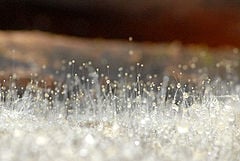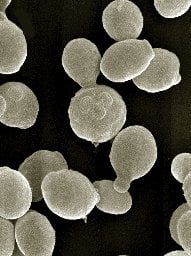Saving the Planet with Mushrooms
Mycology is the study of Fungi
Mycology is the study of fungi and, of course, fungi create mushrooms. To be clear, mushrooms are the "fruiting body" of a fungus. The rest of the organism is designed to extract nutrients from its surroundings; much the way a pant does.
There's a Fungus Among Us
Fungi include the stuff that attacks feet (athlete's foot), the mushrooms that are eaten, what makes milk into cheese (and yogurt), grain mush into wine & beer, and even where the most potent and longlasting antibiotic came from; penicillin.
Because fungi are known vectors for disease in plants mycology (the study of fungi) and phytopathology (the study of plant diseases) are still closely linked in the natural sciences.
Because fungi are susceptible to the same bacterial diseases as humans* it makes sense that a defense against bacteria developed in fungi would work about as well in humans.
Vanguards of Recycling
Six ways Mushrooms may save the world according to Dr. Paul Stamets.
- Mushrooms clean polluted water (oyster mushroom mycelium in particular)
- Mushrooms eat insects and other plant pathogens
- Mushrooms create fuel from biomass (mycelium breaks down lignum and cellulose; the fibrous structure of trees)
- Mushrooms can help prepare soil for plants
- Mushrooms can break down nerve gas (VX in particular)
- Mushroom can kill bacterial infections (TB is in the cross-hairs); mushrooms also seem to target viruses
How Mycelium Breaks Down Matter
Mycelium, unlike a plant, uses acids it creates to break down complex organic compounds. This means that mycelium can break down wood fiber (lignum/cellulose) and hydrocarbons. Since these acids reside in the fungus its important that the fungus itself is protected from the very acids it produces. For that reason the outer shell of mycelium "shoots" is made of of chitin; the same substance that protects shellfish and insects.
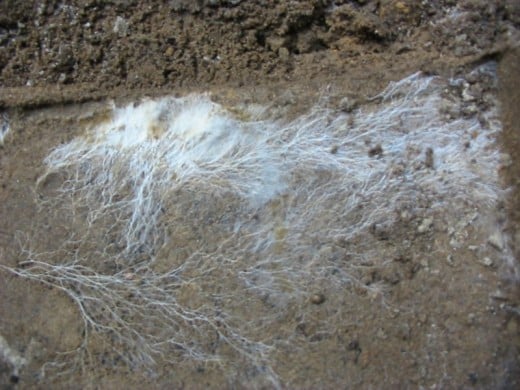
As a Water Cleaner
Mycelium from Oyster Mushrooms, grown on wood chips, and placed in burlap sacks have been shown to reduce downstream pollutants in water one hundred fold.
Mycelium is the "root" body of the mushroom. The mushroom itself is the fruit bearing or reproductive part of fungus. As such, mycelium absorbs nutrients from its surroundings. It does this by first breaking down the bonds in larger structures, such as the lignum in wood, in to smaller monomers (biological polymers). The mycelium then feasts on the simpler bonds.
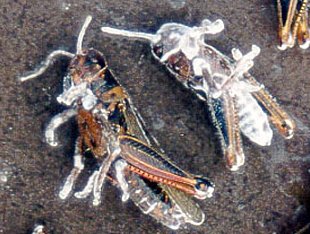
Insect Control
Entomopathogenic fungus is a mycelium known to attack insects. Typically the attack is initially external, involving only the insects outer shell, but eventually the mycelium invade the body and kill the insect either with toxins or simply by using all of the available material in the insect to reproduce. Typically a tropical environment is required for this to take place with relatively high heat and humidity.
If the insect attacked is a hive insect the fungal spores have an excellent chance of lying dormant until the queen has been infected. Once this happens the whole hive will likely die since the queen is the only entity within the hive that reproduces.
Mycelium can also attack nematodes, root worms, that often cause destruction to edible plants. The mycelium attacks the nematodes by lassoing them and then extracting nutrients from them.
Fungi as a Biohazard Cleanup Compound


Mycelium produces Fuel
Because mycelium is capable of breaking down complex organic molecules it can also convert wood fiber (lignum/cellulose) into simple sugars. From there another form of mycelium can convert the simple sugars into ethonol.
Dr. Stamets calls this particular hydrocarbon econol.
The fungi Mucor indicus can break down the cellulosic and lignin fibers into 189 grams of xylose and 29 grams glucose per kilogram of cellulosic fiber.
The fungi Pichia stipilis can then be used to convert these simple sugars into ethanol. P. stipitis had a better performance in ethanol production at
identical conditions with ethanol yield 0.38 gram for gram of the sugars. i.e. for every gram of sugar p. stipulis converted 38% of it to ethanol.
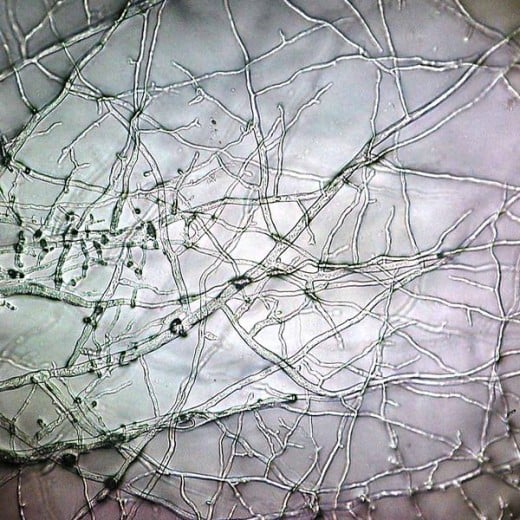
Mycelium as Soil Preparation
Because mycelium is capable of breaking down organic matter it is an excellent means of recycling forest wastes into material new trees and plant growth can use as nutrients. Mycelium not only breaks down the organic matter in the forest, it also leaves tiny cavities in the soil where air and water can percolate down into the earth.
Mycelium, once it has fruited into spores, also encourages the very bacteria it was able to fight off into proliferating in the area it once inhabited. Because these bacteria further break down the organics in the soil they also encourage larger lifeforms to grow there.
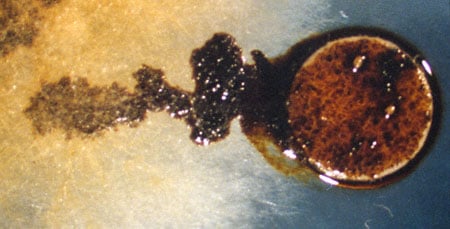
Mycelium to Break Down Toxics
It has been found that the Oyster Mushroom (Pleurotus ostreatus) is capable of breaking down the complex hydrocarbons that constitute oil. Further, some strains of p. ostreatus are capable of living quite well in salt-water.
By creating oil booms (Dr. Stamets calls them mycobooms) of burlap packed with straw and p. ostreatus his group hopes to have a better solution for containing and mitigating off-shore oil leaks.
In one experiment with deisel fuel contaminated soil, the Stamets team found that they could reduce the concentration of hydrocarbons in diesel contaminated soil from 10,000 parts-per-million (ppm) to less than 200 ppm in 16 weeks. This involved treating the soil with 25% oyster mushroom mycelium.
Since VX and other nerve "gases" are also complex compounds similar to hydrocarbons, mycelium has the potential (as yet unannounced by DARPA) of breaking down these dangerous substances without using high heat and risky procedures.
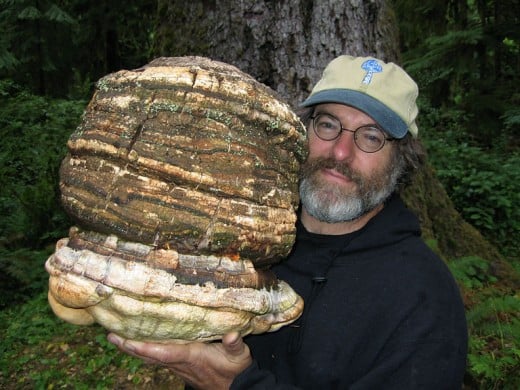
Mycelium as Antibiotic
Tuberculosis is one of the deadliest and hardest to treat ailments in human history.
Dr. Stamets has found historical data indicating that the ancient Greek used Agarikon (Laricifomes officinalis), a type of large mushroom found in old-growth forests, to treat "consumption" also known as TB. Other indigenous people of the pre-Columbian Americas also used this mushroom to treat smallpox. There is some speculation that these treatments were so effective that the pre-Columbian Americans were left susceptible to diseases brought from Europe during conquest.
Pliny the elder wrote that Agrikon is good for:
"spider and scorpion bites, protection against noxious drugs, after vomiting, as a component of the Mithridate formula, to strengthens the stomach, to ease breathing difficulties, to benefit the kidneys, to relieve sciatica and pains in the spine, to act as an aperient (mild laxative), for the disorder of the spleen, for troubles of the hypochondria and groin, diseases of the bladder and to eliminate stones, to cure stranguary, to cure injuries of the achilles tendon and shoulder pain, to help cure tuberculosis, to help indigestion, to cure epilepsy, to relieves the chills of fever, to cure dropsy, to cure jaundice, to help heal bruises and the bad effects of falls, and to relieve hysterical suffocations accompanied by delayed menstruation."
Research on Agrikon is ongoing, but ancient texts often serve as sign-posts important in the rediscoveries of long forgotten treatments.
Footnotes
* Fungi and humans are more closely related than plants and humans.

